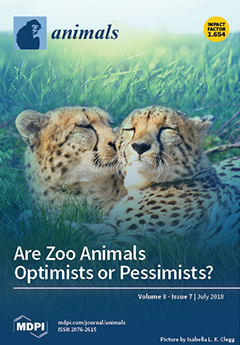Trigeminal-nerve-mediated headshaking represents a major welfare challenge for owners and veterinarians and is caused by a low threshold firing of the trigeminal nerve resulting in pain manifested as violent head jerking that often terminates the horse’s career and life due to poor quality of life and suffering. As metabolic changes such as acid–base status and electrolytes play a role in nerve firing, this study sought to assess the effects following administration of hypertonic solutions on headshaking behavior in affected horses. This prospective randomized controlled crossover design utilized six horses affected with trigeminal-mediated headshaking and three treatment groups receiving intravenous administration of 5% dextrose solution at 2 mL/kg bwt (DS), NaCl 7.5% at 4 mL/kg bwt (HS), or NaHCO
3 8.4% at 2 mmol/kg bwt (HB). Horses were assessed for headshaking behavior changes at times T0 (baseline, before infusion) and T15, 30, 60, 120 min post infusion. Venous blood variables: pH, HCO
3−, standard base excess (SBE), Na
+, Cl
−, K
+, Ca
2+, Mg
2+, total magnesium (tMg), glucose, and lactate were measured at T0 (baseline, before infusion) and T5, 15, 30, 60, 120 min post infusion. Strong ion difference (SID) and anion gap (AG) were calculated for each time point. With HB treatment, there was greater than 50% reduction in headshaking rate. There was an effect of time on increasing headshaking rate. There was an effect of breed on headshaking rate. Changes in blood parameters following DS were virtually absent. Infusion of HS caused mild changes and did not vary much from baseline except for SID and AG. Only infusion of HB caused blood pH and HCO
3− to be outside of the physiologic range (alkalemia and metabolic alkalosis, respectively), SBE to double or triple, AG to decrease, and SID to increase compared to baseline. Infusion of DS was followed by increase in blood glucose and decrease in blood Na
+. Infusion of HS was followed by increase in Na
+ and Cl
− and decrease in Mg
2+. Infusion of HB was followed by decrease in Mg
2+. Blood tMg, K
+, and Ca
2+ decreased slightly, but did not vary greatly from baseline following any of the treatments, remaining within physiologic ranges. Changes in blood composition were transient. Among all treatments, only HB had an effect on headshaking rate. The limited effects following these fluids were likely due to normal mechanisms of regulation of blood levels of pH and electrolytes. Further investigations of changes in electrolytes that might affect nerve firing should be explored.
Full article






